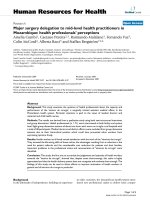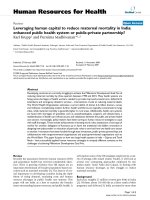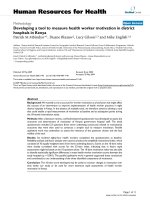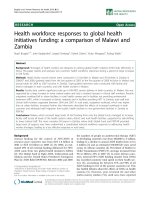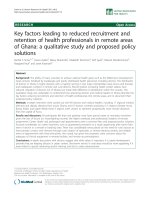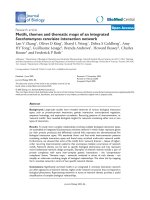Báo cáo sinh học: "Stenotrophomonas maltophilia resistant to trimethoprim – sulfamethoxazole: an increasing problem" docx
Bạn đang xem bản rút gọn của tài liệu. Xem và tải ngay bản đầy đủ của tài liệu tại đây (205.09 KB, 3 trang )
BioMed Central
Page 1 of 3
(page number not for citation purposes)
Annals of Clinical Microbiology and
Antimicrobials
Open Access
Case report
Stenotrophomonas maltophilia resistant to trimethoprim –
sulfamethoxazole: an increasing problem
Asma Marzouq Al-Jasser*
Address: MBBS, King Saud University Fellowship of Pathology (Microbiology), Jordanian Board (Microbiology & Immunology), Certification
Board in Infection Control and Epidemiology(CIC), Consultant Microbiologist, Department of Microbiology. Armed Forces Hospital, Box X-966,
P.O. Box 7897. Riyadh – 11159, Saudi Arabia
Email: Asma Marzouq Al-Jasser* -
* Corresponding author
Abstract
Stenotrophomonas maltophilia (S. maltophilia) has recently emerged as an important nosocomial
pathogen. Treatment of invasive infections caused by this organism is difficult as the bacterium is
frequently resistant to a wide range of commonly used antimicrobials. Trimethoprim-
sulfamethoxazole (TMP – SXT) is recommended as the agent of choice for the treatment of S.
maltophilia infections. However, the development of resistance to this antibiotic represents a real
challenge to laboratorians and clinicians.
This letter describes the first isolation of S. maltophilia resistant to TMP – SXT from two patients
treated at Riyadh Armed Forces Hospital which is a major tertiary hospital in Saudi Arabia.
Background
S. maltophilia is becoming increasingly recognised as an
important nosocomial pathogen [1,2]. The increase is
most likely due to an increase in the patient population at
risk because of the advances in medical therapeutics that
include: the aggressive treatment of malignancy, the
increase in invasive therapeutic devices and the increased
utilization of broad – spectrum antimicrobials [3]. S. mal-
tophilia has emerged as a significant cause of morbidity
and mortality in cancer patients [3,4]. In severely ill
patients, S. maltophilia causes a wide range of infections
such as bacteremia, pulmonary infections, urinary tract
infections, wound infections, meningitis and endocarditis
[2-4]. Treatment of invasive S. maltophilia infections is dif-
ficult because this pathogen shows high levels of intrinsic
or acquired resistance to different antimicrobial agents
thus drastically reducing the antibiotic options available
for treatment [1,3,5]. The selection of agents for use in the
management of infections due to S. maltophilia represents
a challenge to laboratorians and clinicians because of the
problems associated with in vitro susceptibility testing, the
inherent resistance of the bacterium to many antimicro-
bial agents and the limited clinical trials to determine the
optimal therapy [6-8]. In vitro susceptibility testing of S.
maltophilia must be interpreted with caution. For most
antibiotics, inconsistent results were obtained from differ-
ent susceptibility testing methods [9]. Disc diffusion
methods are deemed inaccurate and of poor reproducibil-
ity as the agar composition and the duration of incuba-
tion may influence the results. Quinolone agents,
particularly ciprofloxacin, appear most problematic in
this respect [3,9]. The National Committee of Clinical
Laboratory Standards (NCCLs) currently recommends
testing for minimal inhibitory concentrations (MICs) by
the use of the agar or the broth dilution method [8].
Published: 18 September 2006
Annals of Clinical Microbiology and Antimicrobials 2006, 5:23 doi:10.1186/1476-0711-5-
23
Received: 28 July 2006
Accepted: 18 September 2006
This article is available from: />© 2006 Al-Jasser; licensee BioMed Central Ltd.
This is an Open Access article distributed under the terms of the Creative Commons Attribution License ( />),
which permits unrestricted use, distribution, and reproduction in any medium, provided the original work is properly cited.
Annals of Clinical Microbiology and Antimicrobials 2006, 5:23 />Page 2 of 3
(page number not for citation purposes)
TMP – SXT has been recommended for use in the treat-
ment of S. maltophilia infections based on the in vitro sus-
ceptibility data which confirm its high activity and the
favourable outcomes observed in patients treated with
this agent [3,6]. Although the role of the combination
antimicrobial therapy in treating infections due to strains
that are susceptible to TMP – SXT is uncertain but the
addition of one or more agents to which the isolate is sus-
ceptible in vitro is a reasonable consideration if the patient
is critically ill or has an underlying haematological malig-
nancy [4,6,7]. Several reports have shown that the preva-
lence of strains that are resistant to TMP – SXT is
increasing [3-5,7,10,11]. The rate of resistance to TMP –
SXT ranges from 2% in Canada and Latin America to 10%
in Europe [10]. Reported here are two cases of S. mal-
tophilia infection which were found to be resistant to TMP
– SXT.
In the first case, S. maltophilia was isolated on 16/7/2005
from a 48 years old Saudi female. She received a course of
cytotoxic chemotherapy to control the blast cell transfor-
mation of her chronic myeloid leukemia. Thereafter, she
was given a three week course of intravenous antibiotics
(meropenem 1 gram every 8 hours, gentamicin 2 mg/kg
twice daily and vancomycin 1 gram every 12 hours) for
the treatment of febrile neutropenic episodes. Then she
was admitted to general intensive care unit (GICU) with
septic shock. Meanwhile, a bone marrow aspirate showed
no response to the course of chemotherapy given. After
her death, a blood culture set taken from the central
venous catheter grew S. maltophilia. No organism was iso-
lated from the other set of blood taken simultaneously via
a percutaneous venipuncture. The Hickman catheter tip
culture showed no growth.
The second organism was isolated on 10/10/2006 from a
65 years old Saudi male who had carcinoma of the urinary
bladder with end stage renal disease. He was admitted to
the urology ward due to obstructive uropathy. Bilateral
percutaneous nephrostomy tubes and a uretheral catheter
were introduced to relieve the obstruction. Prior to admis-
sion, he received oral norfloxacin 400 mg twice daily for 3
days. After admission, norfloxacin was replaced by intra-
venous ceftriaxone 2 grams once daily for one week. A
urine specimen collected from the left percutaneous
nephrostomy tube grew S. maltophilia. He was clinically
stable with no local signs of infection. The cultures of
urine specimens from both the right percutaneous neph-
rostomy tube and the uretheral catheter were negative.
Both nephrostomy tubes were changed later and the
repeated urine cultures showed no growth. Both organ-
isms were identified with 99% confidence by the Analyti-
cal Profile Index (API) 20 NE (Biomeriux, France). The
sensitivity testing was done by the automated MicroScan
system. Interpretation of the MICs was based on the
guidelines of the NCCLs [8]. Both isolates were resistant
to TMP – SXT (MIC > 8/152 ug/ml by MicroScan system
and MIC > 32 ug/ml by Etest strip). The two isolates were
also resistant to gentamicin (MIC > 8 uglml), both mero-
penem and imipenem (MIC > 16 ug/ml) and cipro-
floxacin (MIC > 4 ug/ml). They were sensitive to
ceftazidime (MIC < 2 ug/ml) and ticarcillin – clavulanate
(MIC = 16/2 ug/ml). The sensitivities to amikacin, chlo-
ramphenicol, tetracycline, levofloxacin, aztreonam and
piperacillin – tazobactam were variable between the two
isolates.
Several studies have recommended the consideration of
the use of TMP – SXT as the initial agent of choice for the
treatment of serious S. maltophilia infections [6,7]. The
addition of another antimicrobial agent to the initial reg-
imen should be considered if there is a significant inci-
dence of resistance to TMP – SXT among the isolates in a
particular facility [5-7,9]. Other useful agents which have
demonstrated in vitro activity against S. maltophilia
include: some quinolones (levofloxacin, gatifloxacin,
moxifloxacin and clinifloxacin), tygecyclin, polymyxins
(colistin and polymyxin-B) and rifampicin [11-13]. Varia-
tions have been observed with different synergestic stud-
ies (broth and agar dilutions, checkerboard and half-
checkerboard techniques as well as time-kill curves).
Combinations identified to be synergestic by the checker-
board method were not found to be so by killing curve cri-
teria [3,11]. Studies have shown that non-synergestic in
vitro combinations have been associated with successful
therapeutic outcomes [3,5]. Also, it is important to note
that synergy may not occur at clinically achievable con-
centrations [15,16]. Therefore, it is difficult to draw firm
conclusions from different in vitro synergistic studies not
only because of different methodology used and wide
combinations tested but also because of strain to strain
variation since synergy may be strain dependent [3,14-
16]. Randomized trials on potentially efficacious agents
singly and in combinations are warranted. The antibio-
gram of both of our isolates suggests a possible role of
other antimicrobials eg. ceftazidime, ticarcillin – clavu-
lanate.
The isolation of S. maltophilia which is resistant to TMP –
SXT at our institution is alarming. The proposed strategies
to prevent S. maltophilia infection should be encouraged
and they include: the avoidance of inappropriate use of
antibiotics, the avoidance of prolonged implementation
of foreign devices, the reinforcement of hand hygiene
practices and the application of appropriate infection con-
trol practices. The microbiology laboratory also plays a
vital role in controlling S. maltophilia infections by contin-
uous monitoring of the prevalence, the provision of local
antibiogram data and the performance of synergistic stud-
ies which may help to guide therapy selection.
Publish with BioMed Central and every
scientist can read your work free of charge
"BioMed Central will be the most significant development for
disseminating the results of biomedical research in our lifetime."
Sir Paul Nurse, Cancer Research UK
Your research papers will be:
available free of charge to the entire biomedical community
peer reviewed and published immediately upon acceptance
cited in PubMed and archived on PubMed Central
yours — you keep the copyright
Submit your manuscript here:
/>BioMedcentral
Annals of Clinical Microbiology and Antimicrobials 2006, 5:23 />Page 3 of 3
(page number not for citation purposes)
References
1. Lennett EH, Baburs A, Hausler WJ, Shadomy HJ: Manual of Clinical
Microbiology. 9th edition. Washington DC: American Society for
Microbiology .
2. Koseoglu O, Sener B, Gulmez D, Altun B, Gur D: Stenotropho-
monas maltophilia as a nosocomial pathogen. New Microbiol
2004, 27:273-279.
3. Denton M, Kerr KG: Microbiological and clinical aspects of
infection associated with Stenotrophomonas maltophilia. Clin
Microbiol Rev 1998, 11:57-80.
4. Micozzi A, Venditti M, Monaco M, Friedrich A, Taglietti F, Santilli S,
Martino P: Bacteremia due to Stenotrophomonas maltophilia in
patients with hematological malignancies. Clin Infect Dis 2000,
31:705-711.
5. Tsiodras S, Pittet D, Carmeli Y, Eliopoulos G, Boucher H, Harbath S:
Clinical implications of Stenotrophomonas maltophilia resist-
ant to trimethoprim-sulfamethoxazole: a study of 69
patients at 2 university hospitals. Scand J Infect Dis 2000,
32:651-656.
6. Smit WJ, Boquest AL, Geddes JE, Tosolini FA: The antibiotic sus-
ceptibilities of Xanthomonas maltophilia and their relation to
clinical management. Pathology 1994, 26:321-324.
7. Vartivarian S, Anaissie E, Bodey G, Sprigg H, Rolston K: A changing
pattern of susceptibility of Xanthomonas maltophilia; implica-
tions for therapy. Antimicrob Agents Chemother 1994, 38:624-627.
8. National Committee for Clinical Laboratory Standards. Per-
formance standards for antimicrobial susceptibility testing 15th informa-
tional supplement (M 100 – S15). National Committee for Clinical
Laboratory Standards Wayne Pa 2005.
9. Pankuch GA, Jacobs MR, Rittenhouse SF, Appelbaum PC: Suscepti-
bilities of 123 strains of Xanthomonas moltophilia to eight B-
lactams (including B-lactam – B – lactamase inhibitor combi-
nations) and ciprofloxacin tested by five methods. Antimicrob
Agents Chemother 1994, 38:2317-2322.
10. Gales AC, Jones RN, Forward KR, Linares J, Sader HS, Verhoef J:
Emerging importance of multi-drug resistant Acinetobacter
species and Stenotrophomonas maltophilia as pathogens in
severely ill patients: geographic patterns, epidemiological
features and trends in the SENTRY Antimicrobial Surveil-
lance Program (1997–1999). Clin Infect Dis 2001, 32:104-113.
11. San Gabriel P, Zhou J, Tabibi S, Chen Y, Trauzzi M, Saiman L: Anti-
microbial susceptibility and synergy studies of Stenotropho-
monas maltophilia isolates from patients with cystic fibrosis.
Antimicrob Agents Chemother 2004, 28:168-171.
12. Weiss K, Restieri C, De Carolis E, Laverdiere M, Guay H: Compar-
ative activity of new quinolones against 326 clinical isolates
of Stenotrophomonas maltophilia. J Antimicrob Chemother 2000,
45:363-365.
13. Giamarellos-Bourboulis EJ, Karnesis L, Galani I, Giamarellou H: In
vitro killing effect of moxifloxacin on clinical isolates of Sten-
otrophomonas maltophilia resistant to trimethoprim-sulfam-
ethoxazole. Antimicrob Agents Chemother 2002, 46:3997-3999.
14. Felegie TP, Yu VL, Ruwans LW, Yee RB: Susceptibility of Pseu-
domonas maltophilia to antimicrobial agents, singly and in
combination. Antimicrob Agents Chemother 1979, 16:833-837.
15. Chow AW, Wong J, Bartlett KH: Synergistic interactions of cip-
rofloxacin and extended spectrum beta – lactams or
aminoglycosides against multiple drug resistant Pseu-
domonas maltophilia. Antimicrob Agents Chemother 1988,
32:782-784.
16. Giamarellos-Bourboulis EJ, Karnesis L, Giamarellou H: Synergy of
colistin with rifampin and trimethoprim/sulfamethoxazole
on multi-drug resistant Stenotrophomonas maltophilia. Diagn
Microbiol Infect Dis 2002, 44:259-263.

